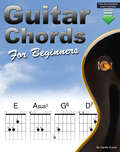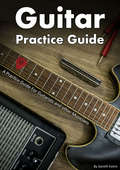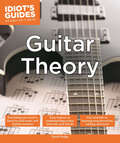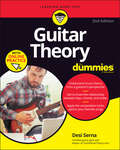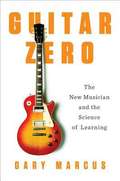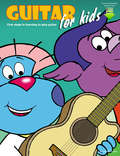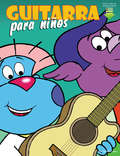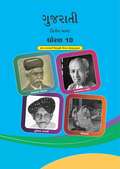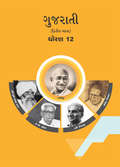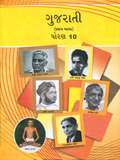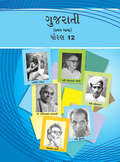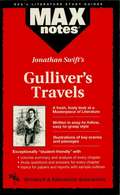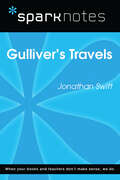- Table View
- List View
Guitar Chords for Beginners: A Beginners Guitar Chord Book with Open Chords and More
by Gareth Evans“It's a very comprehensive book containing chords from the beginning stages and beyond. Everything is very well explained with no stone left unturned. I'd highly recommend it to anyone who's starting out with the guitar.” Nigel Elliott, Guitarist & Tutor (N.Ireland)Guitar Chords for Beginners contains 65 different chords arranged in easy fingerings.- TechniqueFretting hand technique for playing guitar chords is looked at in detail with diagrams. Where necessary, some chords are taught incrementally because taking on only the harder aspects of a chord’s fingering first means our hand is freer to adjust. Other chords are shown with different fingerings for you to choose which you prefer. Playing guitar chords may seem like a contortion for the hands of the beginner so there is some basic guidance on stretching to keep the hands flexible.- Audio and MoreEach guitar chord has a downloadable audio example enabling you to hear if you have played it right, or to hear what you need to work towards. There is an introduction to moveable power chords and barre chords, in which barre chords are shown as easier cut-down versions of full barre chord shapes. At the back of Guitar Chords for Beginners there is a list of suggested songs that contain chords from within the book.Grab a copy today!"Looks fab. I particularly like the different ways of playing the A chord. The physical warm-up exercises for flexibility are also good. It is good that movable major and minor barre chords are shown as partial versions to make them initially easier, and beginners might find extra interest where near the back of the book easy open versions of other more exotic chords are shown, such as Dm(maj7), the "James Bond" chord." Campbell Murray, RGT & MU Registered Tutor (Scotland)
Guitar Practice Guide: A Practice Guide for Guitarists and other Musicians
by Gareth EvansA 5900 word Practise Guide for Guitarists. Important areas are covered (listed below) giving a grounding on how to approach practise generally and make improvements on the guitar. Various issues you may come across are discussed with guidance on how to deal with them. Where appropriate, statements are backed-up by references to scientific research papers. Subject covered include the following: How much Practise How Often Concentration Patience Physical Limits Small Intermittent Breaks Mental Limits Coordination Sense of Timing and Rhythm How to Stay in Time Practise Speed Download your Free Practise Guide for Guitarists Now!
Guitar Theory (Idiot's Guides)
by David HodgeMusic theory is often considered to be one of the most difficult subjects to learn. Idiot's Guides: Guitar Theory breaks down music theory for guitar and other fretboard instruments in very simple and easy-to-understand lessons. Content includes everything a budding musician needs to know about notes, guitar tablature, rhythm, chords and scales, and more.
Guitar Theory For Dummies with Online Practice: Book + Online Video And Audio Instruction
by Desi SernaMake your guitar sing with insight on music theory brings your instrument to life There’s a universe of incredible music living in your guitar. You just need to discover how to let it out. In Guitar Theory For Dummies, expert guitarist and instructor Desi Serna walks you through the music theory concepts you need to understand to expand your musical horizons. From deciphering the mysteries of the fretboard to adapting chord progressions to a song’s key, you’ll master techniques that will help you move past simple, three-chord songs to more complex and creative pieces. Build on your existing knowledge of open and barre chords and simple progressions with practical instruction that demystifies scales and chord voicings and shows you how to bring them together to create impressive music. You can also jump over to dummies.com to hear audio samples of the examples featured in the book. You’ll also learn: How chords, keys, and scales are built and how they interact with one another Powerful concepts, like intervals, chord extensions, modes and modal scales, that grant access to a world of musical possibilities How popular songs apply elements of guitar theory and how you can apply the same techniques Free yourself from the confines of tab sheets and simple chords and start enjoying all the musical potential of your guitar. Guitar Theory For Dummies is for anyone who wants to unlock the next stage of their musical journey.
Guitar Zero: The New Musician and the Science of Learning
by Gary MarcusOn the eve of his 40th birthday, Gary Marcus, a renowned scientist with no discernible musical talent, learns to play the guitar and investigates how anyone—of any age —can become musical. Do you have to be born musical to become musical? Do you have to start at the age of six?Using the tools of his day job as a cognitive psychologist, Gary Marcus becomes his own guinea pig as he takes up the guitar. In a powerful and incisive look at how both children and adults become musical, Guitar Zero traces Marcus’s journey, what he learned, and how anyone else can learn, too. A groundbreaking peek into the origins of music in the human brain, this musical journey is also an empowering tale of the mind’s enduring plasticity. Marcus investigates the most effective ways to train body and brain to learn to play an instrument, in a quest that takes him from Suzuki classes to guitar gods. From deliberate and efficient practicing techniques to finding the right music teacher, Marcus translates his own experience—as well as reflections from world-renowned musicians—into practical advice for anyone hoping to become musical, or to learn a new skill. Guitar Zero debunks the popular theory of an innate musical instinct while simultaneously challenging the idea that talent is only a myth. While standing the science of music on its head, Marcus brings new insight into humankind’s most basic question: what counts as a life well lived? Does one have to become the next Jimi Hendrix to make a passionate pursuit worthwhile, or can the journey itself bring the brain lasting satisfaction?For all those who have ever set out to play an instrument—or wish that they could—Guitar Zero is an inspiring and fascinating look at the pursuit of music, the mechanics of the mind, and the surprising rewards that come from following one’s dreams. .
Guitar Zero: The Science of Becoming Musical at Any Age
by Gary MarcusOn the eve of his 40th birthday, Gary Marcus, a renowned scientist with no discernible musical talent, learns to play the guitar and investigates how anyone--of any age --can become musical. Do you have to be born musical to become musical? Do you have to start at the age of six? Using the tools of his day job as a cognitive psychologist, Gary Marcus becomes his own guinea pig as he takes up the guitar. In a powerful and incisive look at how both children and adults become musical, Guitar Zero traces Marcus's journey, what he learned, and how anyone else can learn, too. A groundbreaking peek into the origins of music in the human brain, this musical journey is also an empowering tale of the mind's enduring plasticity. Marcus investigates the most effective ways to train body and brain to learn to play an instrument, in a quest that takes him from Suzuki classes to guitar gods. From deliberate and efficient practicing techniques to finding the right music teacher, Marcus translates his own experience--as well as reflections from world-renowned musicians--into practical advice for anyone hoping to become musical, or to learn a new skill.Guitar Zero debunks the popular theory of an innate musical instinct while simultaneously challenging the idea that talent is only a myth. While standing the science of music on its head, Marcus brings new insight into humankind's most basic question: what counts as a life well lived? Does one have to become the next Jimi Hendrix to make a passionate pursuit worthwhile, or can the journey itself bring the brain lasting satisfaction?For all those who have ever set out to play an instrument--or wish that they could--Guitar Zero is an inspiring and fascinating look at the pursuit of music, the mechanics of the mind, and the surprising rewards that come from following one's dreams.
Guitar for Kids: First Steps in Learning to Play Guitar with Audio & Video
by Gareth Evans“Gareth has written a really well thought out first book for teaching young children how to play. This one is definitely the one I'll be using.” Bob Lucas - Bob Lucas Guitar Studios (Missouri US)Guitar For Kids is a fun all-colour guide on the first steps of learning to play Guitar with over 70 photographic examples, purpose-made diagrams and cartoons. Starting with advice on buying your first guitar, how to hold the guitar and how to tune it, the music then begins with easy-to-play melodies using only open strings (open strings means only the plucking hand is used), before moving to simple pieces in which the fretting hand is also used. The book goes into detail for some basic techniques because you're better off getting it right from the start rather than develop bad habits.Tablature Based - Guitar for Kids uses mostly guitar tablature making this popular instrument more easily accessible for beginners (as do most adult guitar method books). The rhythmical aspect of Sight-reading is covered within the Chords section which eases-in the later Sight-reading section because the only new thing to learn will be reading different notes from the musical staff.Audio Tracks - Guitar for Kids comes with 47 downloadable audio tracks with musical pieces in styles such as Rock, Blues, Pop, Flamenco, Jazz and Reggae. Each piece has a full band demo track and accompanying backing track with guitar part removed for you to play over.What Else? - EZ chords are covered (easy chords with less notes) and are accompanied with diagrams of the full versions for later on, or if you feel like a challenge. There’s an introduction to Power chords with Rock pieces to play named after healthy greens “Broccolli Rockilly” and “Rocket Salad”. There's a Blues and Rock duet with backing band tracks to play with a friend, and at the end there is a Quiz, no cheating!Grab a copy today!Please Note: The eBook includes musical pieces so is not suitable for smaller screens.“I looked through Guitar for Kids thoroughly when I received it and I think its great. I will be recommending that my students buy one.” Chris Nastri, Bachelor of Education (B.Ed) Phoenix Arizona US"It looks like Gareth spent a lot of time writing Guitar for Kids. I think the illustrations are very helpful in keeping people's minds interested and engaged." Tim Woosley - Music Director, Lincoln School of Music (Nebraska)
Guitarra para niños: Primeros pasos para aprender a tocar la guitarra con audio y vídeo
by Gareth EvansGuitarra para niños es una guía divertida de los primeros pasos para aprender a tocar la guitarra con más de 70 ejemplos fotográficos, diagramas específicos y dibujos animados. Comenzando con consejos sobre la compra de tu primera guitarra, cómo sostener la guitarra y cómo afinarla, la música comienza con melodías fáciles de tocar usando sólo cuerdas abiertas (cuerdas abiertas significa que sólo se usa la mano que pulsa las cuerdas), antes de pasar a piezas sencillas en las que también se usa la mano que pulsa. El libro explica detalladamente algunas técnicas básicas porque es mejor hacerlo bien desde el principio en lugar de desarrollar malos hábitos. Basado en tablaturas - Guitarra para niños usa mayormente tablaturas de guitarra haciendo este instrumento popular más accesible para los principiantes (como lo hacen la mayoría de los métodos de guitarra para adultos). El aspecto rítmico de la lectura musical está cubierto en la sección de acordes, lo que facilita el proceso cuando llega la sección de la lectura musical completa, porque entonces lo único nuevo para aprender será leer las notas del pentagrama musical. Pistas de audio - Guitarra para niños viene con 47 pistas de audio descargables con piezas musicales en estilos como rock, blues, pop, flamenco, jazz y reggae. Cada pieza tiene una pista de demostración de la banda y una pista de acompañamiento con la parte de la guitarra eliminada para que la toques. ¿Qué más? - Los acordes fáciles están cubiertos y se acompañan con diagramas de las versiones completas para más tarde, o si te gustan los desafíos. Hay una introducción a los acordes de potencia con piezas de rock para tocar. Hay un dúo de blues y rock con temas de banda de acompañamiento para tocar con un amigo, y al final hay un cuestionario, ¡sin trampas! Nota: El libro electrónico incluye piezas musicales por lo tanto no es adecuado para pantallas pequeñas.
Gujarati (Apexit) class 12 - GSTB - Navneet: ગુજરાતી પ્રશ્નસંગ્રહો ધોરણ ૧૨ (માર્ચ, 2020ની બોર્ડ-પરીક્ષા માટે લેટેસ્ટ પેપર-પેટર્ન અનુસાર)
by Navneetધોરણ ૧૨ ગુજરાતી અપેક્ષિતમાં વિભાગ A થી વિભાગ E સુધી માં ૨૯ પ્રશ્નસંગ્રહો આપેલ છે અને ૨ આદર્શ પ્રશ્નપત્ર આપેલ છે.
Gujarati Apexit class 10 - GSTB - Navneet: ધોરણ ૧૦ ગુજરાતી પ્રશ્નસંગ્રહો (માર્ચ, 2020ની બોર્ડ-પરીક્ષા માટે લેટેસ્ટ પેપર-પેટર્ન અનુસાર)
by Navneet Ltd.ધોરણ ૧૨ ગુજરાતી અપેક્ષિતમાં ૩૧ પ્રશ્નસંગ્રહો આપેલ છે અને ૨ આદર્શ પ્રશ્નપત્ર આપેલ છે.
Gujarati Semester 2 class 7 - GSTB: ગુજરાતી સેમેસ્ટર 2 વર્ગ 7 - જીએસટીબી
by Gstbઆ પાઠ્યપુસ્તકને અનુભવ, ચિંતન, ઉપયોજન અને નિષ્કર્ષ તારવવાને લગતી પ્રવૃત્તિઓ દ્વારા શિક્ષણને અધ્યેતાકેન્દ્રી બનાવવાનો પ્રયાસ કર્યો છે.પાઠયપુસ્તક દ્વારા પ્રવૃત્તિલક્ષી શિક્ષણની બાબત નાવીન્યપૂર્ણ રીતે પ્રસ્તુત કરવામાં આવી છે. તે દ્વારા અધ્યયન અધ્યાપન પ્રક્રિયા રોચક બનશે.પ્રસ્તુત પાઠ્યપુસ્તક ધોરણ 7 ના દ્વિતીય સત્ર નું છે તેમાં ૧૧ પાઠ અને 2 પુનરાવર્તન છે તેમજ પુરક વાંચન પણ છે.
Gujarati Semester 1 class 6 - GSTB: ગુજરાતી સેમેસ્ટર 1 વર્ગ 6 - જીએસટીબી
by Gstbઆ પુસ્તક ધોરણ ૬ નું ગુજરાતી (સેમિસ્ટર ૧) વિષય નું પાઠ્યપુસ્તક છે .જેમાં ૯ પાઠ છે અને પુનરાવર્તન ૧ અને ૨ પણ છે.
Gujarati Semester 2 class 6 - GSTB: ગુજરાત સેમેસ્ટર 2 વર્ગ 6 - જીએસટીબી
by Gstbઆ પુસ્તક ધોરણ ૬ નું ગુજરાતી (સેમિસ્ટર ૨) વિષય નું પાઠ્યપુસ્તક છે .જેમાં પાઠ ૧૦ થી ૧૮સુધી છે અને પુર્નાવર્તન ૩ અને ૪ છે સાથે પુરક વાંચન માં ૪ પાઠ અને એક કાવ્ય છે .
Gujarati class 4 - GSTB: ગુજરાતી (પાઠ્યપુસ્તક ) ધોરણ 4 - જીએસટીબી
by Mr Kishorebhai Parth Dr. Begging Mr. Yahya Flat Borneaપ્રસ્તુત પાઠ્યપુસ્તકને ગુણવત્તાયુક્ત તથા બાળભોગ્ય બનાવવા માટે પૂરતી જહેમત ઉઠાવી છે. તેના ચતુરંગી સ્વરૂપ દ્વારા બાળકો હોંશે હોંશે તેનો ઉપયોગ કરે એવું લક્ષ્ય રાખવામાં આવ્યું છે.તેમાં પેલા પાઠ માં નાવડી ચાલી છે વાર્તા ને ચિત્ર દ્વારા સરસ રીતે સમજાવેલ છે. પાઠ 2 ઠંડી કવિતા સ્વરૂપે ફ્રીજ માં મુકેલ વસ્તુઓ પોતાની વાત કહે છે.પાઠ 3 સાચી હજ ખુદાને ખુદાઈ પ્યારી છે. તમે ગરીબ હોવા છતાં પેલાં દુઃખી બાળકોને મદદ કરી અને હજનો વિચાર છોડી દીધો, એ જ કારણ છે કે ખુદાના દરબારમાં માત્ર તમારી જ હજ મંજૂર થઈ. પાઠ 4 લાખા વણજારા વિષે વાત કરેલ છે તેમાં તેને વગર વિચારે કુતરા ને મારી નાખ્યો અને એક વફાદાર કુતરા મિત્ર ને ગુમાવી દિહો તે સરસ રીતે સમજાવેલ છે. પુનરાવર્તન 1 આપેલ છે ત્યારબાદ પાઠ 5 ઉખાણા તેમાં 8 ઉખાણા સમજુતી અને ચિત્ર સાથે આપેલ છે. ઝવેરચંદ મેઘાણી ની રાતાફુલ કવિતા આપેલ છે .કલાકાર ની ભૂલ પાઠ માં સરસ વાર્તા દ્વારા સમજુતી આપેલ છે ત્યાર બાદ પુનરાવર્તન 2 આપેલ છે. દ્વિતીય સત્ર માં પત્ર લખવાની મજા ઈશ્વર પરમાર ની વાર્તા છે. હું તો પુછુ સુન્દરમ ની સરસ કવિતા છે . જ્યોતીન્દ્ર દવે દ્વારી લિખી હાસ્ય લેખ જે અકબર બીરબલ ની વાર્તા પર આધારિત છે. ઉટ અને ફકીર વાર્તા દ્વારા સમજુતી આપેલ છે.ત્યારબાદ પુનરાવર્તન 3 આપેલ છે સ્વામી વિવેકાનંદ ના બાળપણ ના જીવન પર આધારિત વાત કહેવામાં આવી છે .પંખી ની જાત ખરેખર દયાળુ છે તે સરસ રીતે સમજવામાં આવ્યું છે. ત્યાર બાદ ચાલો સૈનિક સૈનિક રમીએ અને 2 બહાદુર છોકરા પાઠ આપેલ છે .ત્યારબાદ પુનરાવર્તન 4 અને પુરક વાંચન આપેલ છે. પુરક વાંચનમાં 4 પાઠ આપેલ છે
Gujarati class 5 - GSTB: ગુજરાતી ધોરણ ૫ - જીએસટીબી
by Gstbઆ પાઠ્યપુસ્તકોમાં આપવામાં આવેલી પ્રવૃત્તિઓ એવી રીતે યોજવામાં આવી છે કે, જેથી પ્રવૃત્તિ પછી એ અંગે ચર્ચા અથવા ચિંતન થાય, ઉપયોજન થાય અને શું શીખ્યા એ પણ તારવી શકાય. બાળકોને અવારનવાર વ્યક્તિગત રીતે તેમજ સામૂહિક રીતે નાના કે મોટા જૂથમાં કામ કરવાનો-અધ્યયનનો અવસર મળે એવી આ શિક્ષણ-સામગ્રી છે. પ્રવૃત્તિલક્ષી શિક્ષણની આ તરાહ કદાચ સૌ પ્રથમવાર પ્રયોજાઈ રહી છે. આશા છે કે આ પાઠ્યપુસ્તકોના ઉપયોગ દ્વારા અધ્યયન-અધ્યાપન-પ્રક્રિયા સરળ તેમજ રોચક બનશે. આ તમામ પાસાઓને ધ્યાનમાં રાખી ગુજરાતી માધ્યમનાં બાળકોમાટે ધોરણ 5 ગુજરાતી વિષયની વિદ્યાર્થી-આવૃત્તિ તૈયાર કરવામાં આવી છે. જેમાં પ્રથમ સત્ર માં 1 અને 2 પુનરાવર્તન છે અને 7 એકમ છે એકમ 1 ચિત્રપાઠ છે એકમ 2 પ્રાથના છે,એકમ ૩બોધકથા છે એકમ 4, પ્રકૃતિ ગીત છે, 5મુ એકમ હાસ્યકથા છે. એકમ 6 નર્મદા મૈયા પ્રવાસ વર્ણન છે એકમ 7 ઊર્મિ ગીત છે. દ્વિતીય સત્ર માં 8 મુ એકમ ઊર્મિગીત છે,કદર લોકકથા છે, ભૂલની સજા નાટક છે, હિંડોળો લોક ગીત છે,તેની સાથે પ્રસંગ કથા અને જીવન ચરિત્ર પણ છે પુનરાવર્તન 3 અને 4 પણ છે , પુરક વાંચન માં 4 એકમ આપેલ છે .
Gujarati pratham Bhasha class 9 - GSTB
by Gujarat rajya Shala pathypustak mandal Gandhinagarઆ પુસ્તક ધોરણ ૯ ગુજરાતી પ્રથમ ભાષાનું શૈક્ષણિક પાઠ્ય પુસ્તક છે .
Gujarati Semester 1 - 2 class 3 - GSTB: ગુજરાતી સેમેસ્ટર ૧ અને ૨ ધોરણ ૩ - જીએસટીબી
by Nitaben Upadhyay Manishbhai Suthar Subhashbhai Harijan Shri Patel Kalpesh Patel Hasmukh Patel Mayuriben Chauhan Rameshbhai Trivedi Shri Prajapati Shri Thakkar Shri Goswami Kishorebhai Parth Shri Madhusudan Thakkar Mr. Pravinbhai Machhoya Shri Kapilaben Chowdhury Shri Bhagwanadas Dudhrajia Yahya Sapatwala Meenesh Kumar Shri Mansuri Harshavibhan Patel Ratan Parmar Shri Makwana Shri Desai Shri Gajjar Natwarbhai Nemesh Manilal Wickham Prakashbhai Mehta Shri Nagla Jitendrabhai Kapadia Amaratbhai Rabari Vinodarai Jyotsna Borneaધોરણ ૩ ગુજરાતી પાઠ્યપુસ્તક માં પ્રથમ સત્ર માં ૬ પાઠ તેમજ ૨ પુનરાવર્તન આપેલ છે તેમજ દ્વિતીય સત્ર માં ૭ થી
Gujrati Semester 1 class 7 - GSTB: ગુજરાતી સેમેસ્ટર 1 વર્ગ 7 - જીએસટીબી
by Gstbઆ પુસ્તક ધોરણ ૭ ગુજરાતી વિષય નું પ્રથમ સત્રનું પાઠ્યપુસ્તક છે .
Gulliver's Travels
by Jonathan SwiftGulliver’s Travels: Into Several Remote Nations of the World. Unabridged School Edition (Recommended by CBSE) Class 9th as per CBSE Curriculum 2014.
Gulliver's Travels (MAXNotes Literature Guides)
by Stephen StertzREA's MAXnotes for Jonathan Swift's Gulliver's Travels MAXnotes offer a fresh look at masterpieces of literature, presented in a lively and interesting fashion. Written by literary experts who currently teach the subject, MAXnotes will enhance your understanding and enjoyment of the work. MAXnotes are designed to stimulate independent thought about the literary work by raising various issues and thought-provoking ideas and questions. MAXnotes cover the essentials of what one should know about each work, including an overall summary, character lists, an explanation and discussion of the plot, the work's historical context, illustrations to convey the mood of the work, and a biography of the author. Each chapter is individually summarized and analyzed, and has study questions and answers.
Gulliver's Travels (SparkNotes Literature Guide Series)
by SparkNotesGulliver's Travels (SparkNotes Literature Guide) by Jonathan Swift Making the reading experience fun! Created by Harvard students for students everywhere, SparkNotes is a new breed of study guide: smarter, better, faster.Geared to what today's students need to know, SparkNotes provides:chapter-by-chapter analysis explanations of key themes, motifs, and symbols a review quiz and essay topics Lively and accessible, these guides are perfect for late-night studying and writing papers.
